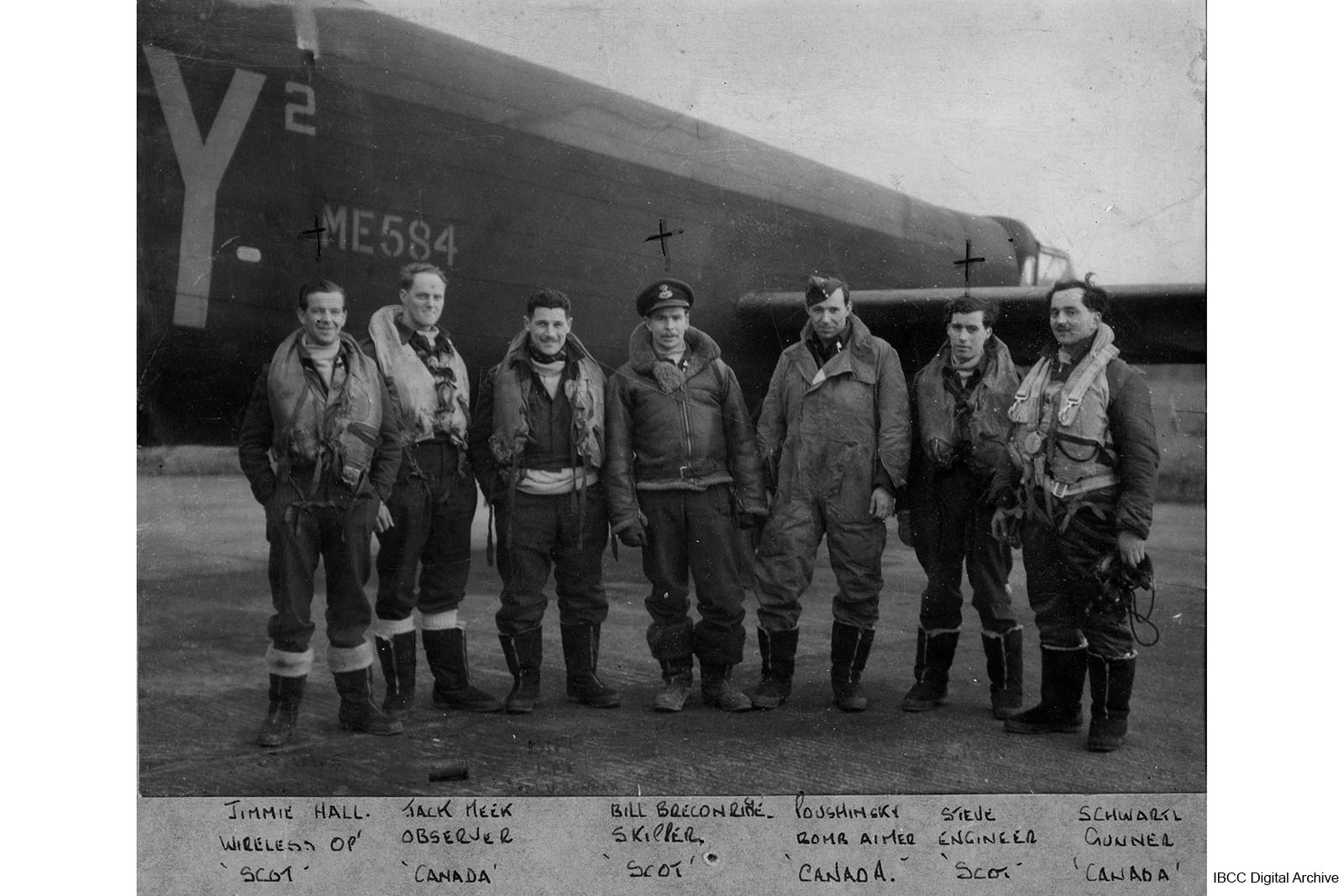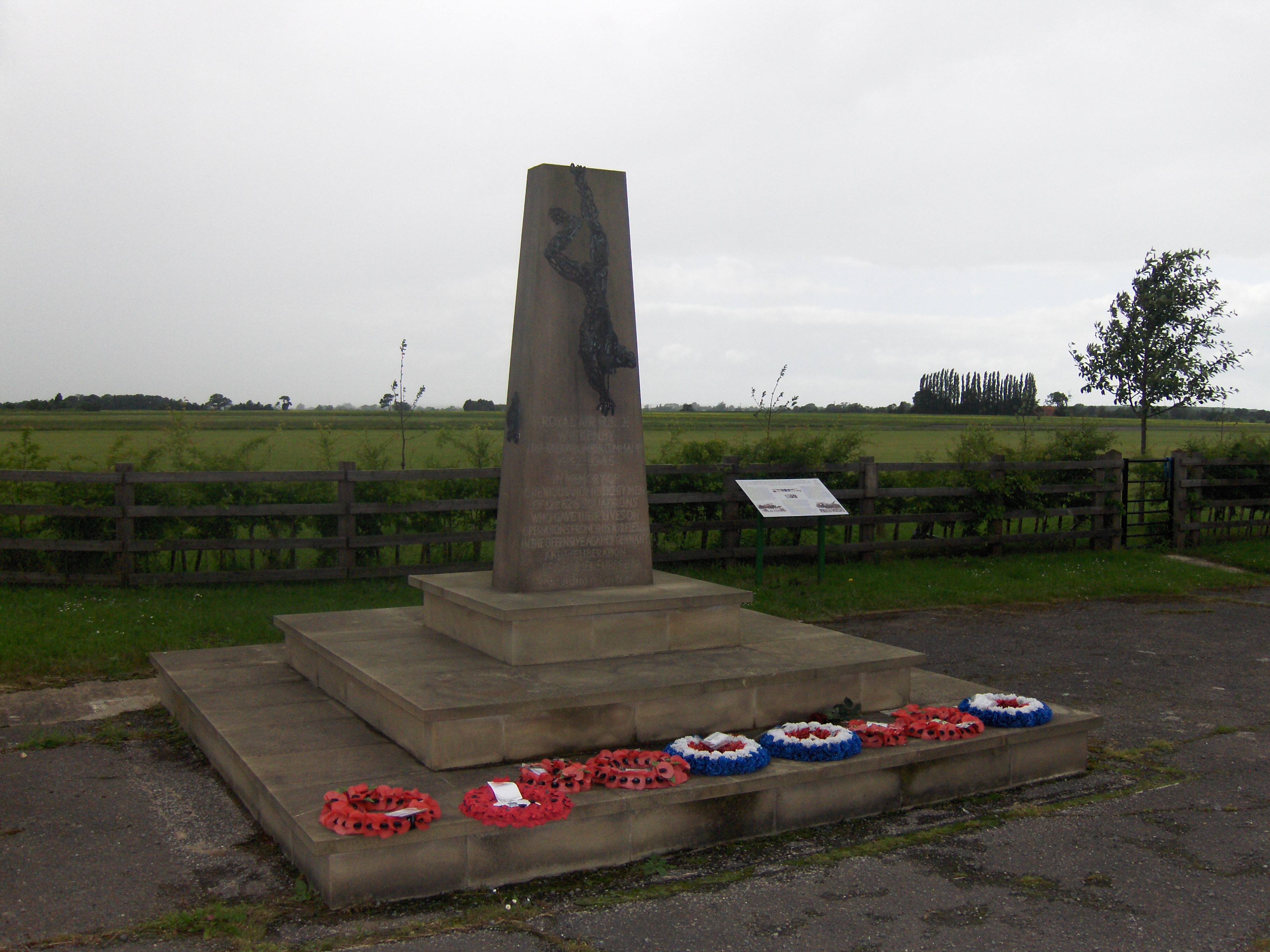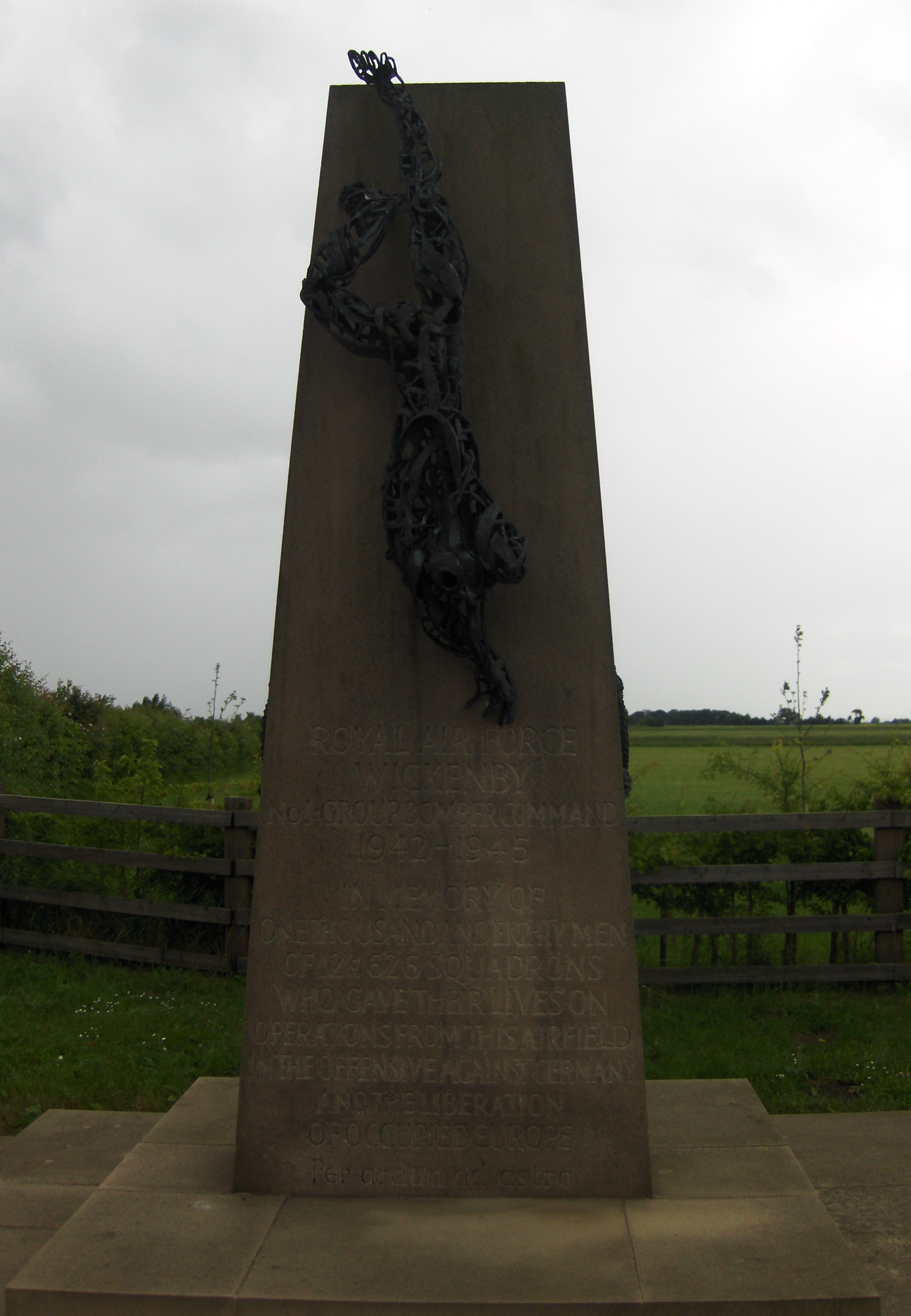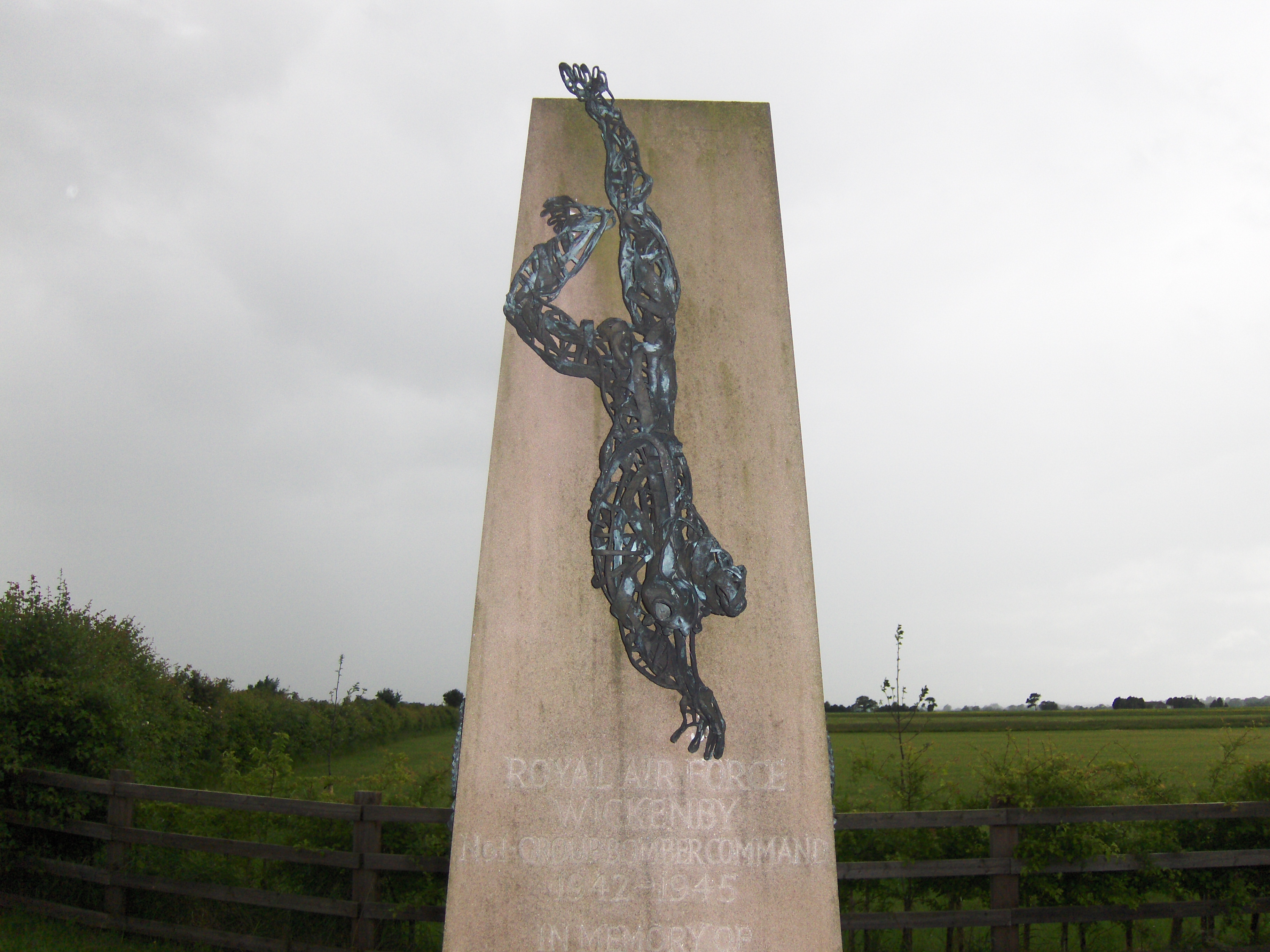| The pilot's account, recorded in the 1970's: THE BERLIN RAID 30/31st January 1944 - Flying Officer Bill Breckenridge's Crew and 626 Squadron RCAF Warrant Officer Richard Jack Meek awarded the Conspicuous Gallantry Medal Being 36 years old he was not a young man by aircrew standards. He was from Vancouver and joined the RCAF in 1941. Jack Meek was navigator on board Lancaster LM584 (UM-Y2) on the Berlin raid of 30/31st of January 1944. It was a disastrous evening for Bomber Command when out of the 440 Lancasters sent on this operation 32 were lost. The crew of LM584 comprised of three Scotsmen, three Canadians and an Englishman. This was their sixth trip together and already they had been to Berlin three times. They had settled on the bombing run when suddenly an unseen fighter attacked at close range, perhaps 200 yards, on the starboard side. The kite shuddered as shells tore into the metal, making a terrific din, so loud it could be heard above the engines. The mid-upper turret was smashed and 'Biff' Baker, the Englishman, a keen amateur boxer, was hit on the side of his face, his helmet and oxygen mask torn away. The rear turret was badly holed and the Canadian, Joe Schwartz, severely wounded by a piece of exploding shrapnel in his foot. Both he and 'Biff' Baker soon lapsed into unconsciousness. The intercom to the rear of the aircraft was u/s so those forward did not know what was happening aft. Bill Breckenridge the skipper, took immediate evasive action, diving to starboard. On recovering, he again levelled out on the bombing run and Val Poushinsky, the Canadian bomb aimer, dropped the load on the estimated position of the markers seen before the attack. A minute later they were again attacked, perhaps by the same fighter, but this time from the port quarter, and at 400 yards. With his two gunners out cold, though he did not know it, the skipper had no warning but dived to port on observing the first tracers coming Ill. The kite was pitching around allover the place as the skipper tried everything he knew to shake off the fighter. The navigator, crouched down behind the skipper, was doubled up from hits and instinctively grabbed his chute before passing out. Things were certainly happening fast. They could not shake off the searchlights or flak, let alone the fighter. It was a madhouse, with the terrific noise of exploding shells and screaming engines. After a further two minutes, the fighter found them again. He closed in from the starboard quarter, at 400 yards, and let forth yet another devastating barrage. This time the skipper was hit, a passing bullet grazing his legs. The original course was resumed from the target area after further violent manoeuvres, but three minutes later came the fourth attack. Again they were hit but the range was now about 500 yards. By the time the fighter was shaken off, their height was down to 15,000 feet. No further attacks came as the skipper, completely unflurried and flying his battered kite as if on a cross-country trip, got away from the area as fast as possible. Slowly the crew began to recover. Jimmy, the wireless op, was found slumped over his set. He was warm but unconscious, so he was given first aid. Not until they landed would they know he was past help. Jack Meek regained consciousness to discover that he had two wounds. One was in his shoulder. The other was caused by shrapnel which went clean through his middle, entering at the right side of his back and emerging at the left front, just below his chest, missing his heart by inches. Though he knew he was badly hit, he would not know the full extent of his injuries until they landed.
'Biff' Baker and Joe Schwartz also revived. The latter extricated himself from his turret, crawled up the fuselage to the rest-bed, but again collapsed. Val Poushinsky rendered first aid to both Schwartz and Meek before taking up a position in the astrodome. Meanwhile, 'Biff' Baker clambered into the still- serviceable rear turret, even though he was injured and without 'oxygen. To make matters worse, the rear fuselage began to fill with smoke soon after leaving the target area. Alex Stephenson, the engineer, went aft and put out the fire.
The kite was in a fearful state. The hydraulic system had been shot away. The bomb doors would not close, nor, as they found later, would the wheels lower. One petrol tank was holed, three rev counters and three boost gauges useless, as were the direction finder and gyro-compass. The elevators and rudders were also badly damaged. Jack Meek's navigational gear was wrecked, but the accurate data on the winds on the route-in now came in handy. All he could do was dead reckon on these, but in reverse. He could not hold up the sextant for his left arm kept dropping down, finally becoming completely useless. Luckily, his figures were good for they took them right back on track. He also took observation of landmarks he knew. When he saw searchlights or flak over German territory he would say to the skipper, "That's Hanover. Go so many minutes in such a direction then bear so much west." Two hours after leaving Berlin he was able to get a Gee fix despite feeling lightheaded from loss of blood and lack of oxygen. They were now over the Zuider Zee and only three miles off track. The open bomb doors caused a lot of drag and the skipper could not get much speed, though he did manage to hold altitude. All were chilled through, due to the many gaping holes, while the lack of oxygen was taking its toll. Over the North Sea the electrical system caught fire, but the mid-upper and flight engineer succeeded in extinguishing the fire after a short, fierce battle. Thirty miles from the English coast the Gee packed up. A distress signal was sent out and in less than a minute the searchlights were homing them in to Docking, on the Norfolk coast. A crash-landing was inevitable. The wheels would not come down, as the air pressure was blown away, and frantic efforts by the skipper and engineer resisted all attempts to unlock them. With the crew at crash positions, the skipper brought the kite in, but she was difficult to control and he had to overshoot. On the second attempt he brought her in like a baby, ran forward on the tail-wheel, nose well up, then slowed. The open bomb doors hit the ground, snapped shut, and suddenly all was quiet. They were down. There was no fire. |





